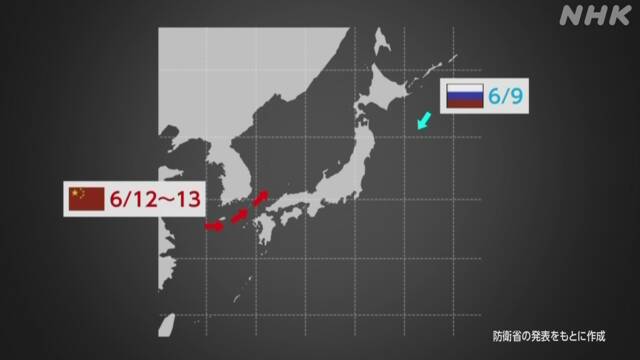After Russia's invasion of Ukraine, the navigation of Russian ships around Japan has been revealed one after another.
Of particular note was the voyage around the Japanese archipelago, which was staggered with Chinese ships last month.
Movement of Russian warships
The series of voyages began on June 9.
The Maritime Self-Defense Force has confirmed that a total of five Russian Navy destroyers and frigates are operating in the Pacific Ocean, about 170 km southeast of the Nemuro Peninsula in Hokkaido.
Six days later, on June 15, it will be confirmed that seven ships, including these five ships and other destroyers, are moving southeast of Cape Erimo, about 280 km south.
The seven vessels sailed off the coast of Chiba Prefecture on the 16th, and passed between Smith Island and Torishima in the Izu Islands on the 17th.
Then, two days later, on June 19, it is confirmed that five ships, excluding one destroyer and one frigate, proceeded northwest between the main island of Okinawa and Miyakojima and entered the East China Sea.
Two days later, on June 21, the five ships entered the Sea of Japan through the Tsushima Strait, and as a result, the Russian Navy's fleet sailed around the Japanese archipelago for more than 10 days, replacing ships. Did.
Movement of Chinese warships
Meanwhile, Chinese ships also sailed around the Japanese archipelago at similar times.
From June 12th to 13th, it is confirmed that four ships, including a guided-missile destroyer and an information gathering ship, proceeded northeast through the Tsushima Strait and entered the Sea of Japan.
After that, the four ships were divided into two, two each,
▽ two missile destroyers in the Soya Strait from June 16th to 17th, and
▽ two ships such as information gathering ships in the Tsugaru Strait on June 16th.
Each passed east.
And on June 19, it is confirmed that three ships, excluding the information gathering ship, are moving southward about 220 km off the coast of Miyagi prefecture in the Pacific Ocean.
The three vessels passed between Smith Island and Torishima in the Izu Islands on June 21, following a route similar to that of Russian warships that had previously traveled south of the Pacific Ocean.
Then, from June 29th to 30th, I went northwest between the main island of Okinawa and Miyakojima, and took about half a month to go around the Japanese archipelago almost once.
Russian and Chinese warships that sailed around the Japanese archipelago at different times.
Yoji Koda, a former chief of staff who served as the commander of the Maritime Self-Defense Force, said, "Since Russia's invasion of Ukraine, the aim is to show off China-Russia cooperation and naval power to Japan and the United States, which are strengthening their stance toward the Indo-Pacific region. I think there was. There is a possibility that such navigation will increase in the future. "
The Ministry of Defense is collecting and analyzing information on the purpose of each navigation.
Deploying U.S. military unmanned aerial vehicles at the SDF base to strengthen surveillance
In order to strengthen the alert and surveillance system with China in mind, which will activate activities in the East China Sea, the Japanese and US governments have decided to deploy the U.S. military unmanned aircraft for the first time at the base of the Self-Defense Forces, and at sea in Kagoshima Prefecture. A plan to deploy it at the Self-Defense Forces Kanoya Air Base is underway.
The unmanned aerial vehicle to be deployed
The planned deployment is the US military unmanned aerial vehicle "MQ9", which has a total length of about 11 meters and a cruising range of 8500 kilometers.
In the past, it was put into military operations in Afghanistan and Iraq, but according to the Ministry of Defense, the unmanned aircraft planned to be deployed at the Kaya base this time is a reconnaissance type for information gathering and equipped with weapons. I'm not saying that.
The Ministry of Defense plans to operate eight unmanned aerial vehicles for one year after a preparation period of about two months after July, and US military personnel involved in the preparation work entered the site on the 20th.
The Ministry of Defense has explained that with the deployment of unmanned aerial vehicles, up to about 200 U.S. military personnel will be stationed and stay at hotels in the city.
U.S. military unmanned aerial vehicle deployment Local
The US and Japanese governments will increase the joint use of the facilities of both countries with China in mind, which will strengthen the movement to advance into the ocean at the ministerial talks on foreign affairs and defense held in January, so-called "2 plus 2". match.
After conducting a field survey at the Kanoya base, in May, I informed the local city of Kanoya of my intention to deploy an unmanned aerial vehicle.
Mayor Nakanishi of Kanoya City announced on July 11 that he would accept the plan as "acceptance is unavoidable" from the viewpoint of security, and then held a briefing session for residents to explain how he decided to accept it. ..
It is unprecedented for U.S. military units to be stationed at the Kaya base for a long period of time, and the impact on civilian life such as the occurrence of incidents and accidents from residents, the prolonged stationing of units, and the expansion of shared use of facilities There were voices concerned about the "US military base".
Under these circumstances, Kanoya City will be on the 21st, the deployment period will be one year and will not be extended, the national government will endeavor to prevent incidents and accidents, and if it does occur, it will be the responsibility of the national government to take appropriate measures, and regional promotion. We have signed an agreement with the Kyushu Defense Bureau that stipulates that the national government should cooperate as much as possible with these efforts.

